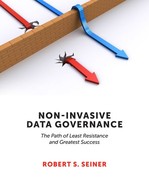0%
19Chapters
0-1Hours read
0kTotal Words
Book Description
Data-governance programs focus on authority and accountability for the management of data as a valued organizational asset. Data Governance should not be about command-and-control, yet at times could become invasive or threatening to the work, people and culture of an organization. Non-Invasive Data Governance™ focuses on formalizing existing accountability for the management of data and improving formal communications, protection, and quality efforts through effective stewarding of data resources.
Non-Invasive Data Governance will provide you with a complete set of tools to help you deliver a successful data governance program. Learn how:
- Steward responsibilities can be identified and recognized, formalized, and engaged according to their existing responsibility rather than being assigned or handed to people as more work.
- Governance of information can be applied to existing policies, standard operating procedures, practices, and methodologies, rather than being introduced or emphasized as new processes or methods.
- Governance of information can support all data integration, risk management, business intelligence and master data management activities rather than imposing inconsistent rigor to these initiatives.
- A practical and non-threatening approach can be applied to governing information and promoting stewardship of data as a cross-organization asset.
- Best practices and key concepts of this non-threatening approach can be communicated effectively to leverage strengths and address opportunities to improve.
Table of Contents
- Acknowledgements
- Chapter 1 Why This Book?
- Chapter 2 Non-Invasive Data Governance Explained
- Chapter 3 Business Value of Data Governance
- Chapter 4 Planning Your Data Governance Program
- Principle 1: Recognize Data as a Valued and Strategic Enterprise Asset
- Principle 2: Assign Data Clearly Defined Accountability
- Principle 3: Manage Data to Follow Internal and External Rules and Regulations
- Principle 4: Consistently Define and Manage Data Quality Across the Data Life Cycle
- Data Governance Maturity Model
- Case Study: Organization Implements Non-Invasive Data Governance Program
- Data Governance Test
- Chapter 5 Best-Practice Development and Critical Analysis
- Chapter 6 Roles and Responsibilities – Introduction
- Chapter 7 Roles and Responsibilities – Operational Layer
- Chapter 8 Roles and Responsibilities – Tactical Layer
- Chapter 9 Roles and Responsibilities – Strategic and Executive Layers
- Chapter 10 Roles and Responsibilities – Supporting Cast
- Chapter 11 Data Governance Tools – Common Data Matrix
- Chapter 12 Data Governance Tools – Activity Matrix
- Chapter 13 Data Governance Tools – Communications Matrix
- Chapter 14 The End Is Only the Beginning
- Index
